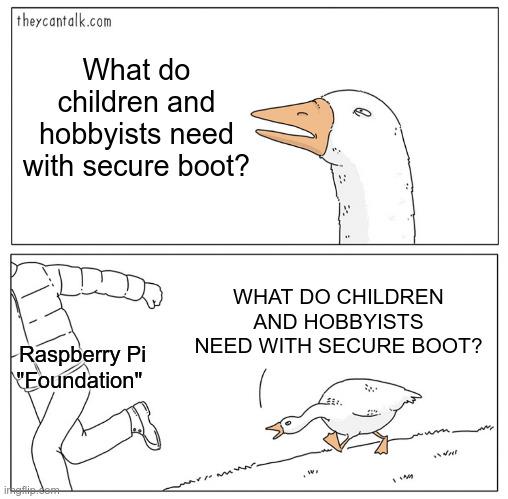- cross-posted to:
- [email protected]
- [email protected]
- cross-posted to:
- [email protected]
- [email protected]
Basically more everything. 2x Cortex M33 cores with floating point, 520KB ram, more PIOs, bunch of secure boot stuff (I have mixed feelings about this), and can boot to a mode with risc-v cores instead of the M33s.
I understand they want it to be a drop in replacement for the original Pico but I wish they upgraded the MicroUSB port to a USB-C port.
I guess third party for me again.
Keeping the same pin layout while upgrading to USB-C would have made more sense. USB-C is the future, seems odd to still be a Micro USB holdout in 2024.
The switch has got to happen at some point, and the Pico ecosystem is still young enough the change wouldn’t be too disruptive.
MicroUSB is absolutely one of the worst connectors ever designed, perhaps only surpassed by the SCART connector.
only surpassed by the SCART connector.
I would rank SCART higher than the composite video RCA connector all of us had to settle for in the NTSC world. SCART was awesome in its day, being able to carry component video AND bidirectional equipment control signals. It was HDMI before HDMI.
The functionality was great, it’s the physical durability that was complete shit.
What was wrong with SCART? only thing I can think of is its bulkiness.
They broke all the time and you had to wiggle them often because of shoddy connectivity.
I don’t remember much problem with the connectivity with SCART. I do remember wasting many hours dealing with cheaply made cables that didn’t even wire all the pins however.
Which come to think of it is now becoming an issue with USB-C cables. At least with SCART the connector could be easily opened for inspection, which became a habit of many an AV tech.
Never broke any. It was a pain to plug in blindly in the back of the TV tho.
After mulling this I think they should have switched, since the original Pico will stay in production, and people can keep using it if they want a literal drop-in replacement. I wonder what the constituency was for staying with micro USB, i.e. that had existing designs that used the Pico but taxed its capabilities.
Remember when the Pi Zero, with a full SoC capable of running Linux instead of just a microcontroller, was $5?
Pepperidge Farm remembers.
It was marketed as $7 (I think), but it was never sold below $15 as far as I could find.
Also, since that price was without any profit margin, merchants only sold them in expensive bundles most of the time (with a case, SD card, etc).
I have personally bought several $5 Pi Zeros. In fact, I’m pretty sure I’ve also bought at least a half-dozen Pi Zero Ws for $5 from Microcenter (pre-pandemic), even though their MSRP was $10 at the time. I distinctly remember them being super cheap, but also limited to one per customer (per trip) at that price, so I’d just pop in and grab one any time I was near the Microcenter.
It was $5 but was limited to one per customer (in practice, one per order) at the usual vendors, and became very scarce at the time other pi models did. The wireless version was $10. They later eliminated the non-wireless version, bumped the wireless version to $15, and introduced a new fancier model (Pi Zero 2) that is also $15.
What is the advantage of a Pico 2 compared to the ESP32 variants?
Better marketing. It’s also easier to get a build pipeline for ARM than Xtensa and RISC-V.
I would say the documentation is more thorough, and at least for the non-wireless versions, there are no mysterious code blobs. The source code to everything including the ROM boot loader is online. The Pico boards also have a nice voltage regulation system so you can run them on a wide range of supply voltages.
How long will it stay $5. Taking bets now.
It might just become unobtanium like the pi zero was til they jacked up the price and dropped the no wifi version.
Added: it still has to compete with the ESP32 so maybe there isn’t that much price headroom, and maybe the ESP32 is why they had to refresh the Pico in the first place.
bunch of secure boot stuff (I have mixed feelings about this)

Is… secure boot considered controversial?
My usual experience with it is having to manually enroll a key on my laptop before I can install Linux or having to disable it entirely. Is the concern here that maybe this is a precursor to a more closed ecosystem?
I mean, there’s “secure boot” as a general concept, and then there’s “UEFI Secure Boot.”
The latter definitely had those concerns, especially around 2012 when it first became a thing and a lot of folks were concerned that Microsoft would try to use it to lock down devices to only run Windows. See also:
The level of concern seems like it’s died down a lot since then, not really so much because the Free Software community “won” but because Microsoft backed off a little bit and everybody kind of got used to it (and also because, at this point, we’ve got bigger fish to
fryjailbreak, such as Android devices and such). But that frog is still in the pot, and the water hasn’t cooled off…
As for the former, which is what this discussion is about since we’re obviously not talking about Microsoft or Windows, my cynicism is mostly about how secure boot is a feature obviously aimed at industrial/commercial users. In other words, it represents yet more distraction away from and neglect of the core constituencies – schoolchildren and hobbyists – that the Raspberry Pi Foundation is supposed to be serving.
So they are steadily going the way of Texas Instruments? I sincerely wondered for the longest while why TI doesn’t have any rpi clones and then I remembered their governor only values indoctrination in schools instead of actual education.
Idk man, it’s an optional feature that you can program yourself. The only catch is you can only program it once.
Can someone fill me in on the intended usecases for something like this? If I wanted to make a personal cloud storage (nextcloud or similar) with a bunch of HDDs for example, would this be ok or underpowered to manage that?
The Pico is a microcontroller board more like an Arduino. it’d be great as the motherboard of a weather station or something.
These aren’t meant for complex things or even to install a full operating system kernel on or for moving data files. These are more for controlling electronics directly. Something you’d find inside a very specialized device like maybe controlling the speed of an air filter fan based on information from a few environmental sensors.
I run all of my DIY keyboard builds (here’s the latest) off of Pi Picos or clones with USB-C.
Yes, way too underpowered. This is for controlling your 3D printer or stuff like that.
I think it’d be easier to use the normal raspberry pi instead in that case.
I just posted a link to a review by someone who has been playing with it for a while and talks about a lot of use-cases: https://lemmy.ml/post/18938549
How is this not considered spam?
This is literally just an ad for a product. It even has the price in the title for crying out loud!
And to top it off, it’s posted by an account that I’m pretty sure reported me for spam, because I posted a tech-philosophy essay where the site mentioned at the end that the essay was also published in a zine.
Lol, and just immediately downvoted. Lemmy needs that essay more than I thought! Too easy to be reactive without accountability on this platform, sadly
Meanwhile, Texas Instruments offers an overpriced sbc that is less user friendly and probably loaded with security vulnerabilities since it was designed for IoT applications https://www.ti.com/tool/BEAGL-PLAY-SBC#supported-products
That’s more like an old school raspberry pi (runs Linux etc), not like a Pico. I didn’t know about that specific version but variants of the Beagleboard and Beaglebone have been around forever (longer than the raspberry pi). They are better than the rpi in some ways, and at least some of them are more open, but Rpi knocked the rug out from under them in cost and performance. I wouldn’t be so sure of the security of the wireless Pico either.
TI isn’t in the business of marketing and selling these types of devices to hobbyists etc.
They tried, look at the TI Launchpad boards. They are still around but less emphasized now. Some of them are actually pretty nice, or were during their day. The originally MSP430 one sold for a long time for $4.30 and later ones were in the $10-20 range depending.
This is a completely different category of device.
My point is that its one of their few offerings, and that they really aren’t even trying to be competitive when we all know they could and probably should.
Oh hey, Raspberry Pi still exists.
Did they ever fire that cop?
The Pico never really took off, honestly. I doubt this thing is going to fly off the shelves or anything.
Idk about took off but it was a successful product by reasonable standards. I have a few of them and chose it for a product that ended up going nowhere. That was partly because of hardware add-ons available for the pico but not for comparable boards. The existence of that 3rd party hardware ecosystem itself shows that the pico did ok.
They apparently sold 4 million units of the pico family. Given the product, I’d say that isn’t amazing, but not a failure, either.












